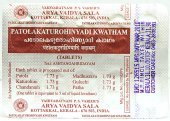Madhusrava, Madhusravā, Madhu-srava, Madhushrava, Madhuśrava: 13 definitions
Introduction:
Madhusrava means something in Hinduism, Sanskrit, biology. If you want to know the exact meaning, history, etymology or English translation of this term then check out the descriptions on this page. Add your comment or reference to a book if you want to contribute to this summary article.
The Sanskrit term Madhuśrava can be transliterated into English as Madhusrava or Madhushrava, using the IAST transliteration scheme (?).
In Hinduism
Ayurveda (science of life)
Nighantu (Synonyms and Characteristics of Drugs and technical terms)
Source: WorldCat: Rāj nighaṇṭu1a) Madhusravā (मधुस्रवा) is another name for Mūrvā, a medicinal plant identified with Marsdenia tenacissima from the Asclepiadoideae or “milkweed family” of flowering plants, according to verse 3.19-21 of the 13th-century Raj Nighantu or Rājanighaṇṭu. The third chapter (guḍūcyādi-varga) of this book contains climbers and creepers (vīrudh). Together with the names Madhusravā and Mūrvā, there are a total of twenty-eight Sanskrit synonyms identified for this plant.
1b) Madhusravā (मधुस्रवा) is also mentioned as a synonym for Haṃsapādī, a medicinal plant possibly identified with Adiantum lunulatum Burm. from the Pteridaceae family of flowering plants, according to verse 5.109-113. The fifth chapter (parpaṭādi-varga) of this book enumerates sixty varieties of smaller plants (kṣudra-kṣupa). Together with the names Madhusravā and Haṃsapādī, there are a total of twenty-six Sanskrit synonyms identified for this plant. Note: Haṃsapādī is claimed as a variety of Lajjālu by Dh. and Rājanighaṇṭu.
2) Madhusrava (मधुस्रव) is another name for Moraṭā, an unidentified medicinal plant, according to verse 3.92-93. Moraṭa is identified variously as either a) the root of the sugercane (Ikṣumūla), b) Aṅkolapuṣpā (Alangium lamarckii), c) Hastikarṇa-Palāśā or as a synonym of Mūrvā (both identified as Leea macrophylla), d) Maerua arenaria, e) Moīhar (Maerua arenaria).
Unclassified Ayurveda definitions
Source: Wisdom Library: Āyurveda and botanyMadhusravā (मधुस्रवा) is another name for Hemajīvantī, which is a Sanskrit word referring to Dregea volubilis (sneeze wort). It is classified as a medicinal plant in the system of Āyurveda (science of Indian medicine) and is used throughout literature such as the Suśrutasaṃhita and the Carakasaṃhitā. The synonym was identified in the Rājanighaṇṭu (verse 6.183), which is a 13th century medicinal thesaurus.

Āyurveda (आयुर्वेद, ayurveda) is a branch of Indian science dealing with medicine, herbalism, taxology, anatomy, surgery, alchemy and related topics. Traditional practice of Āyurveda in ancient India dates back to at least the first millenium BC. Literature is commonly written in Sanskrit using various poetic metres.
Purana and Itihasa (epic history)
Source: archive.org: Puranic EncyclopediaMadhuśrava (मधुश्रव).—A sacred place in Kurukṣetra, situated near another holy place called Pṛthūdaka. If one bathes in a pond there one will have to his credit the benefit of making a thousand Godānas. (Śloka 15, Chapter 83, Vana Parva).
Source: JatLand: List of Mahabharata people and placesMadhusrava (मधुस्रव) refers to the name of a Tīrtha (pilgrim’s destination) mentioned in the Mahābhārata (cf. III.81.130). Note: The Mahābhārata (mentioning Madhusrava) is a Sanskrit epic poem consisting of 100,000 ślokas (metrical verses) and is over 2000 years old.

The Purana (पुराण, purāṇas) refers to Sanskrit literature preserving ancient India’s vast cultural history, including historical legends, religious ceremonies, various arts and sciences. The eighteen mahapuranas total over 400,000 shlokas (metrical couplets) and date to at least several centuries BCE.
Biology (plants and animals)
Source: Wisdom Library: Local Names of Plants and DrugsMadhusrava [मधुस्रव] in the Sanskrit language is the name of a plant identified with Marsdenia volubilis (L. fil.) Cooke from the Apocynaceae (Oleander) family having the following synonyms: Asclepias volubilis, Dregea volubilis, Wattakaka volubilis. For the possible medicinal usage of madhusrava, you can check this page for potential sources and references, although be aware that any some or none of the side-effects may not be mentioned here, wether they be harmful or beneficial to health.
Source: Google Books: CRC World Dictionary (Regional names)1) Madhusrava in India is the name of a plant defined with Acacia intsia in various botanical sources. This page contains potential references in Ayurveda, modern medicine, and other folk traditions or local practices It has the synonym Mimosa caesia L. (among others).
2) Madhusrava is also identified with Adiantum lunulatum It has the synonym Adiantum lunatum Cav. (etc.).
3) Madhusrava is also identified with Clematis triloba It has the synonym Clematis triloba B. Heyne.
4) Madhusrava is also identified with Cressa cretica It has the synonym Cressa australis R. Br..
5) Madhusrava is also identified with Didymochlaena truncatula It has the synonym Adiantum lunulatum Ogata (etc.).
6) Madhusrava is also identified with Glycyrrhiza glabra It has the synonym Liquiritia officinarum Medik., nom. illeg. superfl. (etc.).
7) Madhusrava is also identified with Leptadenia reticulata It has the synonym Cynanchum reticulatum Retz. (etc.).
Example references for further research on medicinal uses or toxicity (see latin names for full list):
· Fl. Tropical Africa, Convolvulaceae (1963)
· Observationes Botanicae (1781)
· Indian Vet. J. (1967)
· Contributions to the Botany of India (1834)
· Advances in Plant Taxonomy in Northwest China (1992)
· Flora Indica (1768)
If you are looking for specific details regarding Madhusrava, for example health benefits, diet and recipes, side effects, pregnancy safety, chemical composition, extract dosage, have a look at these references.

This sections includes definitions from the five kingdoms of living things: Animals, Plants, Fungi, Protists and Monera. It will include both the official binomial nomenclature (scientific names usually in Latin) as well as regional spellings and variants.
Languages of India and abroad
Sanskrit dictionary
Source: DDSA: The practical Sanskrit-English dictionaryMadhusrava (मधुस्रव).—a. dropping honey or sweetness.
Derivable forms: madhusravaḥ (मधुस्रवः).
Madhusrava is a Sanskrit compound consisting of the terms madhu and srava (स्रव).
Source: Cologne Digital Sanskrit Dictionaries: Shabda-Sagara Sanskrit-English DictionaryMadhusravā (मधुस्रवा).—f.
(-vā) 1. A plant, (Celtis orientalis.) 2. Liquorice. E. madhu honey, snu to drop, affs. ap and ṭāp .
Source: Cologne Digital Sanskrit Dictionaries: Cappeller Sanskrit-English DictionaryMadhusrava (मधुस्रव).—[adjective] dropping honey.
Source: Cologne Digital Sanskrit Dictionaries: Monier-Williams Sanskrit-English Dictionary1) Madhuśrava (मधुश्रव):—[=madhu-śrava] [from madhu] [wrong reading] for -srava and vā q.v.
2) Madhuśravā (मधुश्रवा):—[=madhu-śravā] [from madhu] [wrong reading] for -srava and vā q.v.
3) Madhusrava (मधुस्रव):—[=madhu-srava] [from madhu] mfn. dropping sweetness, [Mahābhārata; Bhāgavata-purāṇa]
4) [v.s. ...] m. Bassia Latifolia, [cf. Lexicographers, esp. such as amarasiṃha, halāyudha, hemacandra, etc.]
5) [v.s. ...] Sanseviera Zeylanica, [cf. Lexicographers, esp. such as amarasiṃha, halāyudha, hemacandra, etc.]
6) Madhusravā (मधुस्रवा):—[=madhu-sravā] [from madhu-srava > madhu] f. Sanseviera Roxburghiana, [cf. Lexicographers, esp. such as amarasiṃha, halāyudha, hemacandra, etc.]
7) [v.s. ...] liquorice, [cf. Lexicographers, esp. such as amarasiṃha, halāyudha, hemacandra, etc.]
8) [v.s. ...] Hoya Viridiflora, [Bhāvaprakāśa]
9) [v.s. ...] a kind of date, [cf. Lexicographers, esp. such as amarasiṃha, halāyudha, hemacandra, etc.]
10) [v.s. ...] = jīvantī, [cf. Lexicographers, esp. such as amarasiṃha, halāyudha, hemacandra, etc.]
11) [v.s. ...] = haṃsa-padī, [cf. Lexicographers, esp. such as amarasiṃha, halāyudha, hemacandra, etc.]
12) [v.s. ...] Name of the 3rd day in the light half of the month Śrāvaṇa, [Catalogue(s)]
13) [v.s. ...] Name of a river, [Catalogue(s)]
14) Madhusrava (मधुस्रव):—[=madhu-srava] [from madhu] n. Name of a Tīrtha, [Mahābhārata]
Source: Cologne Digital Sanskrit Dictionaries: Yates Sanskrit-English DictionaryMadhusravā (मधुस्रवा):—[madhu-sravā] (vā) 1. f. A plant (Celtis orientalis); liquorice.
[Sanskrit to German]
Sanskrit, also spelled संस्कृतम् (saṃskṛtam), is an ancient language of India commonly seen as the grandmother of the Indo-European language family (even English!). Closely allied with Prakrit and Pali, Sanskrit is more exhaustive in both grammar and terms and has the most extensive collection of literature in the world, greatly surpassing its sister-languages Greek and Latin.
See also (Relevant definitions)
Partial matches: Shrava, Madhu, Matu.
Starts with: Madhusravah, Madhusravas.
Full-text: Madhusravas, Matucarava, Hemajivanti, Shrava, Shravas, Hamsapadi, Ompatu, Murva, Morata.
Relevant text
Search found 9 books and stories containing Madhusrava, Madhu-shrava, Madhu-srava, Madhu-śrava, Madhu-śravā, Madhu-sravā, Madhushrava, Madhusravā, Madhuśrava, Madhuśravā; (plurals include: Madhusravas, shravas, sravas, śravas, śravās, sravās, Madhushravas, Madhusravās, Madhuśravas, Madhuśravās). You can also click to the full overview containing English textual excerpts. Below are direct links for the most relevant articles:
Garga Samhita (English) (by Danavir Goswami)
Verse 8.13.19 < [Chapter 13 - A Thousand Names of Lord Balarāma]
Puranic encyclopaedia (by Vettam Mani)
The Skanda Purana (by G. V. Tagare)
Chapter 62 - Manifestation of the Bull-emblemed, Lord < [Section 2 - Uttarārdha]
Chapter 77 - The Greatness of Kedāra < [Section 2 - Uttarārdha]
Chapter 29 - Gaṅgā-Sahasranāma (A Thousand Names of Gaṅgā) < [Section 1 - Pūrvārdha]
List of Mahabharata people and places (by Laxman Burdak)
Amarakoshodghatana of Kshirasvamin (study) (by A. Yamuna Devi)
The Agni Purana (by N. Gangadharan)
Related products


